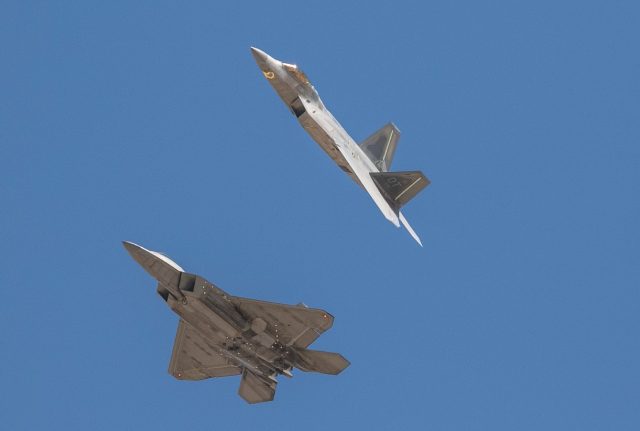The US Air Force’s F-22 Raptor recently became the first fifth-generation fighter aircraft to run third-party software and the first fighter to demonstrate in-flight use of open-source container orchestration software.
Members of the Air Combat Command Federal Laboratory, test pilots at Edwards Air Force Base, and software developers from the 309th Software Engineering Group achieved the milestones on an in-flight F-22 Raptor on August 24.
Fifth-generation fighter aircraft are historically unavailable to third-party software integration. To fix this problem and lower the barriers to entry, the team built and flight-tested their new Open Systems Enclave, or OSE, consisting of a government-owned software architecture with existing on-board hardware.
This new enclave proved it can rapidly integrate new technologies from first line of code to flight in less than 60 days. In recognition of this value proposition, there is now a formal requirement for the establishment of OSE on F-22 at the direction of the chief of F-22 requirements.
“This breakthrough fundamentally changes how we can deliver combat capability to the warfighter,” said Maj. Allen Black, F-22 test pilot and project co-lead. “We’ve proven the ability to rapidly evaluate and integrate next-generation technologies developed by experts in government, industry, and academia at a lower cost with software portability across defense platforms.”
Established in 2018, the ACC Federal Laboratory functions under the Office of the Chief Scientist and operates with a vision to summon and coalesce a “Confluence of Warfighters, Developers, and Acquirers” while bridging advanced technologies with fielded weapon systems. The result is an inspired defense industrial base with intellectual property protection and increased safeguards to mission critical systems.
This confluence model quickly proved its worth in 2020 by achieving a Defense Department first in artificial intelligence when human-AI teaming was flown with an AI copilot, “Artuµ.”
The lab changed public policy in 2021 and established the National Institute for Standards and Technology’s 20th Laboratory Accreditation Program known as Federal Warfare Systems. NIST accreditation standardizes the competence, impartiality, and operational consistency of Federal Laboratories of this type in the DoD, providing senior leaders with published policy to sanction and underwrite this activity.
“The complimentary position of the ACC Fed Lab. within the acquisitions process allows the government to fly before they buy,” said Maj. Ray Tierney, ACC Federal Laboratory founder and director. “This increases modernization throughput, decouples software development from Operational Flight Program cycles, and allows the delivery of advanced capability to assure dominance in strategically competitive environments – creating cost offsets previously believed to be impossible.”
“I speak for the entire team when I say that we are very fortunate and thankful to receive early and continuous support from warfighters, leaders, and commanders within the 412th Test Wing, 9th Reconnaissance Wing, 1st Fighter Wing, ISR/SOF Program Executive Office, F-22 Program Office, Air Force Materiel Command, and Air Combat Command,” said Dr. John Matyjas, ACC’s chief scientist and senior executive to the ACC Fed Lab. “This backing has meaningfully empowered today’s achievement – and harnesses a cross-platform approach to software-based capability development in costs and timelines relevant to the warfighter.”
ACC Federal Laboratory says this milestone shines a bright future for software acquisition in the DoD, one where apps are rapidly developed, matured and delivered to the warfighter at the push of a button. Initially working with F-22 Program Office as an early adopter of OSE, the team is evaluating and integrating several candidate combat capabilities as cross-platform solutions.



























